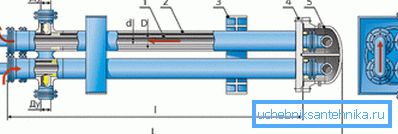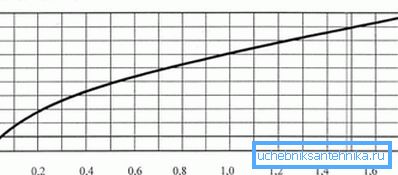Practical heat exchanger pipe in pipe - design features
Comfortable living can only be in cases where we are satisfied and get all the benefits of modern life, including a sufficient amount of heat. But we will not talk about the general heating system, but consider the heat exchanger pipe in the pipe - with your own hands which is difficult to build, but more about this in more detail in the following sections.

Familiarity with the design
To begin, I would like to tell you about the features of the product, which are characteristic of this particular type of heat exchanger:
- The principle of construction consists in the construction of large-diameter pipes in which products of smaller diameter are placed — heating fluid will flow through them.

Note! The difference in cross-section is also necessary with the possibility of accelerating the movement of a liquid; this makes it possible to heat large areas with lower costs.
- The heat exchanger is created in such a way that in case of detection of defects and the need for repair it was possible to disconnect one part and replace it.. It is enough just to shut off the hot water supply.
- A heat exchanger like a pipe in a pipe is interesting because of its high flow rate, through which a large volume of liquid used as a coolant can be transported..
Pros and cons of design
Now let's proceed directly to identifying the positive and negative characteristics of the selected heat exchanger:

Benefits
Based on the design features, several essential qualities can be distinguished:
- Stable transportation of coolant through the pipes is guaranteed, because, as we indicated earlier, the volume of the moving fluid is easily regulated by the pipes used. Moreover, the diameters of products can be edited directly during the installation of the heating system. (See also the article Distribution of heating pipes: features.)
- Again, the above feature about the possibility of partial dismantling generates a definite plus - cleaning the heating system takes only a few hours.
Note! Such designs of heat exchangers are easy to maintain, there is no need for preventive actions to the extent that emergency services are recommended. Occasionally, it is sufficient to add special agents that scrape away the deposits from the inner walls of the pipeline.

- The use of any coolant is allowed: water, steam, gaseous media and viscous fuel. It all depends on which option is most suitable for you and your country house, the price of fuel becomes the decisive factor.
disadvantages
And now let us point out the negative qualities that are generated by the same features of the chosen construction:
- Due to the placement of the channel, the heat exchanger inside the pipeline increases the overall dimensions of the system, since the minimum diameter used is 100 mm. You can, of course, install narrower pipes, but this will adversely affect throughput.
- The disadvantages include the high cost of construction, this is due to several factors:
- The need for hired workers to install the system.
- Increased consumption of materials for the construction of the heating pipeline.
- It is also better to entrust the calculation of the heat exchanger to a pipe in a pipe to specialists, and for this you will have to pay extra.

But if you still want to save a little, the next section will help with this.
Design design features
Correct calculations and a detailed drawing are the key to a positive and effective result.
If your budget does not allow you to apply to special organizations, and you will be engaged in this process yourself, then the instruction is as follows:
- Determine the material that will serve as the basis for the design - it depends on it the efficiency and the range of fuel used.
- Calculation of the useful area of the heat exchanger depending on the area that needs to be heated. You must understand that the larger the dimensions of the “internal” pipes, the more heat will flow into the room.
- The strength of the materials used, which must be guaranteed to operate for several decades.
- Take into account the hydraulic characteristics of the system that transports the fuel for heating.
- To bypass all communications, so as not to install, not under some unforeseen circumstances, they are not affected.
- Pay particular attention to window openings and the front door, which are the main sources of cold and heat loss.
Note! Do not forget that the long-term piped heating system has a slight drawback - the coolant temperature will gradually decrease.
Now there is a finished drawing of the heat exchanger pipe in the pipe to show the workers who will be engaged in welding the system and wait for the finished result. At this time, to determine the choice of the team, which will produce the installation of the structure. (See also the article Single-pipe heating system: features.)

Conclusion
The pipe in the pipe - as you can see, the heat exchanger is very efficient and is able to create a favorable environment in your home for living. Of the existing drawbacks, only one can be called essential - the dimensions of the structure, since it is necessary to plan in advance the niches and place for the installation of the system. This will be problematic in the already finished living quarters, as it will be necessary to redraw the habitable interior.
In the presented video in this article you will find additional information on this topic.